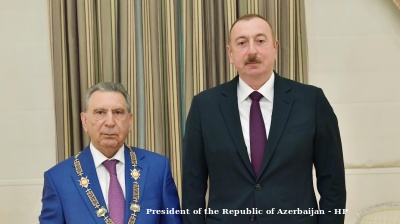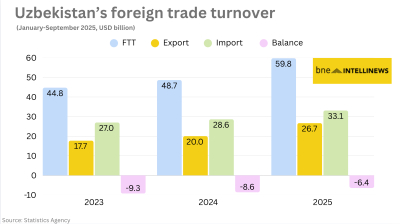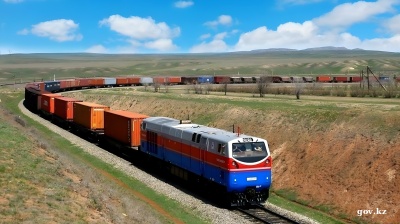Uzbekistan has overtaken Ukraine to become the second most populous country in the former Soviet Union as the war-torn countries population plummets.
Uzbekistan had 34.9mn people as of June according to the UN and by far the youngest and fastest growing population of the Former Soviet Union (FSU) states. With an average age of 29.1 as of January 2022 and an extraordinary 2.33 births per woman, the population grew by 1.6% between 2021 and 2022.
That made Uzbekistan the second biggest population in the former Soviet Union after Russia (146mn).
Ukraine was already suffering a demographic crisis before the war started. As the poorest country in Europe, a fifth of the labour force had already left to seek better paid jobs in the EU and Russia. On top of that the fertility rate in 2022 was 1.4 births per woman -- well below the replacement rate.
As bne IntelliNews reported, Emerging Europe is already suffering from a demographic crisis that will take population levels back to the early 20th century in the coming decade. Germany has a fertility rate of 1.6 in 2023. By contrast, a UN study found the populations in Central Asia are booming and are all expected to grow in the next few decades.
Thanks to the relative prosperity that Russian enjoyed following the end of the recession in the middle of this decade plus a pro-birth government policies as featured by bne IntelliNews’ Putin’s babies, Russian fertility rates recovered to 1.8 in 2023 – one of the highest in Europe – from record lows in the middle of the decade when the fertility rate fell to a record low 1.5.
Nevertheless, Russia is also suffering from a demographic crisis that will take Emerging Europe population levels back to the early 20th century as the dent in the demographic curved cause by the crashing life expectance in the 1990s now hits the working age population.
Ukraine population crash
The situation in Ukraine has gone from bad to worse thanks to the war, but it was already in trouble before the fighting started. The pre-war 45mn head count was already controversial as Ukraine has not held a formal census since 2000.
Ukraine’s population fell behind that of Poland for the first time after a cut price electronic census revealed the number of citizens had dropped by some 5mn people to 37.289mn in 2020 since the last census in 2000. Eurostat also estimated the actually population size to be 37.98mn in 20218.
But the war has made the demographics far worse by driving millions into exile in neighbouring countries. In addition to the approximately 6mn economic migrants that left the country before the war, an addition circa 8mn refugees have fled since Russia invaded over a year ago – predominately women and children – which will only reduce the fertility rate further. Estimating the total number of refugees that left is made difficult by the fact that millions have since returned home, unable to find work abroad or pulled back as the situation normalises in parts of the country.
Now the population seems to have fallen by another 8mn people. the study counted 29mn souls in Ukraine today, sparking concerns over the future of the country’s demographic future, according to a study from the Ukrainian Institute of the Future, Ukraine Business News reported on June 6.
Only 9.5mn citizens are estimated to be in employment, 6-7mn if you exclude state employees, who must carry the remaining 23mn people including pensioners, children, students, unemployed people, dependents, etc. the study estimates that 8.6mn citizens are now living abroad and an alarmingly low fertility rate that has fallen below 1.0 since the war started. The institute warns that there will be twice as many pensioners in Ukraine as there are working people within a few years unless a change is made.
“That is why the issue of demography should be voiced by the President of Ukraine as a priority for today and which requires urgent measures,” the institute stated.
Oleksiy Miroshnychenko, president of the Confederation of Employers of Ukraine, warns that the depleted workforce could result in a slower pace for Ukraine’s recovery. He noted that the number is greater than Germany’s workforce losses after World War II, when the country lost 16% of its workers, around 4.7mn people.
Victoria Gryb, a member of the Ukrainian Parliament, stressed that the Ukrainian government must create incentives for people to return to the country. The lack of human resources could result in an economic decline of UAH348.5bn, 6.5% of Ukraine’s GDP, Gryb noted.
As such, she believes it is crucial that millions of specialists return to the country, with the government introducing special programmes, conditions and motivation to encourage people to come back to work. In addition, she suggested strong financial support for families and raising payments for newborns. Labour migrants are another option to grow the economy.
It remains unclear how many of Ukraine’s refugees will return home should the war end. In the early stages of the war, most said they would go home as soon as hostilities stopped, but more recent surveys have suggested that half of those in exile now intend to stay there in countries like Poland and Germany as they build a new life and find work.
In a depressing study released last summer, a UN study predicted that Ukraine’s population will never recover from the war. The UN Population Prospects projections indicate that while the country’s population will recover to some extent from 2023 onwards – assuming the war ends within months – it will never again reach the 43.3mn seen at the beginning of 2022. Ukraine’s population will gradually decline until 2100 by which time it will have fallen to under 20.6m the study predicts.
Features

Emerging Europe’s growth holds up but risks loom, says wiiw
Fiscal fragility, weakening industrial demand from Germany, and the prolonged fallout from Russia’s war in Ukraine threaten to undermine growth momentum in parts of the region.

The man who sank Iran's Ayandeh Bank
Ali Ansari built an empire from steel pipes to Iran's largest shopping centre before his bank collapsed with $503mn in losses, operating what regulators described as a Ponzi scheme that poisoned Iran's banking sector.

Andaman gas find signals fresh momentum in India’s deepwater exploration
India’s latest gas discovery in the under-explored Andaman-Nicobar Basin could become a turning point for the country’s domestic upstream production and energy security

The fall of Azerbaijan's Grey Cardinal
Ramiz Mehdiyev served as Azerbaijan's Presidential Administration head for 24 consecutive years, making him arguably the most powerful unelected official in post-Soviet Azerbaijan until his dramatic fall from grace.



